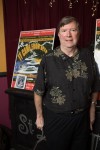Cornell Christianson uses a scene from the sci-fi film “Invaders from Mars” as the backdrop for his latest musical. Set in front of images of a sandy hill, characters are captured by aliens who have just descended from their spaceship.
The UCLA alumnus’ off-Broadway show, “It Came From Beyond,” officially opened April 24 at St. Luke’s Theatre in New York City and will run every Tuesday until July. The production will also return to Los Angeles in September, where its previous showing in 2006 won six nominations for LA STAGE Alliance’s Ovation awards. The musical is set in a science classroom in the 1950s and follows a high school student who imagines his classmates have merged into the comic book he is reading. Christianson said the show draws a parallel between the real and the fictitious worlds, a technique he often uses in his works.
“It Came From Beyond” isn’t Christianson’s first musical nor period piece. In 2005 he began working on a 1940s film noir musical as well as a 1950s musical about Marilyn Monroe. His most recent play, however, is his first sci-fi project. Christianson grew up collecting monster trading cards and comic books and watched films such as “The War of the Worlds” and “Invasion of the Body Snatchers.”
“People who know the (movies) get a big kick out of it,” Christianson said. “Because they know these famous shots.”
During a time when the United States was threatened by a nuclear attack from the Soviet Union, Christianson said he found an escape in sci-fi movies. Defeating foreign invaders such as monsters and aliens gave him hope.
The musical’s protagonist, Harold, is a stereotypically “geeky” boy who searches for the secret to conducting telekinesis in a comic book to save a popular girl he admires. Accompanied by a chorus, five actors play dual roles of real life and comic book characters, a theatrical device Christianson uses to bridge the two parallel worlds, he said.
To underscore the show’s plot, Christianson crafted “dummy lyrics” which served as unfinished placeholders for the final songs. He then recruited composers Norman Thalheimer and Stephen M. Schwartz, who shared his love for 1950s sci-fi, he said.
Thalheimer said they transformed Christianson’s initial work into 12 complete musical numbers over the course of six weeks.
“Those dummy lyrics were essential in terms of just being able to hold the place,” Thalheimer said. “To give us some kind of clarities with what to write in that specific moment.”
When composing for “It Came From Beyond,” the duo did not try to stay exclusively within the 1950s genre, Schwartz said. Rather, the two drew from experiences with the music they grew up with and loved. Even though the musical was set in the ’50s, they looked to genres from other periods, such as rock ‘n’ roll, to make the show accessible for all ages and audiences. Meanwhile, references and scenes from sci-fi films as the production’s backdrop helped ground the musical to its sci-fi roots.
“In New York, we were seeing a lot of young kids … coming to the show,” Schwartz said. “And that is wonderful.”
Thalheimer said the musical’s score includes a mixture of styles, such as saloon ballads and show tunes, that reflect various moments in the sci-fi storyline. For example, in one scene, the audience watches a colonel who, upon seeing a flying saucer, believes a Soviet invasion is taking place. After the saucer lands, he proceeds to interrogate the aliens that descend from their ship as if they are Soviet communists. Accompanying the scene are melodies of an exaggerated, pseudo-Russian music genre.
Christianson said that while other unsuccessful musicals ridiculed and made fun of 1950s sci-fi movies, “It Came From Beyond” does not intend to do so. Rather, it draws from Christianson’s appreciation of monster- and alien-centered plotlines.
“I always wanted to write a musical that paid homage to the ’50s sci-fi movies,” Christianson said. “And I found some songwriters who also loved them.”
